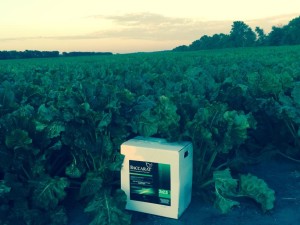Plant Health Products Part of a Growing Trend
The market for plant health products is one of the fastest growing segments in agriculture. According to a 2013 PiperJaffray report, the biological crop protection market sat at about $2 billion, of which biostimulants accounted for $1 billion.
“Micronutrients are gaining much wider recognition and acceptance,” says Dr. Julian Smith, director of Discovery and Innovation for Brandt. “Introducing nutritional products that fit into a grower’s current practices and provide excellent ROI has really advanced the market and helped increase the adoption rate.”

Julian Smith, Brandt
That adoption is a trend seen by several companies.
“Everyone is looking at new and unique opportunities to increase the plants ability to yield,” says Adam Burnhams, Joint COO, SipcamAdvan. It’s about enabling the plant to optimize its nutrients and helping it through periods of abiotic stress.”
In addition to combating stress, which comes from drought, heat, cold, and pests, biostimulants improve plant health and soil fertility. “With biostimulants, we are providing tools to the plants to improve crop efficiency,” Burnhams says.
For many years, biostimulants suffered from a reputation borne of hucksters selling snake oils.
“People came in and they didn’t understand the market,” Burnhams says. “They tried to launch products with little or no research data and then make multiple claims on a crop. People have become very wary of that. The barrier to entry was relatively low.”
It’s an issue that concerns growers no matter where they are in the world.
The team at the Netherlands-based Koppert Biological Systems have seen growers start to overcome their initial negative impressions about the efficacy of products introduced to the market in its early stages. More savvy customers realize there are often huge quality differences between low-cost products and high-value ones.
One thing that has gone a long way toward changing perspectives has been the investment by the multinationals.
Over the last few years, the amount of research dollars spent on biostimulant products has helped them gain credibility, Burnhams says. Some of the multinationals have developed their own products while others scooped up smaller companies whose products have already demonstrated success. Those investments from traditional crop protection companies and the research dollars they can provide go a long way to change growers’ perceptions.

David Beaudreau, co-chair of the Biostimulant Coalition
“A lot of the bigger players that have been historically known for being in the crop protection and seed space have made acquisitions of some of the smaller companies,” says David Beaudreau, co-chair of the Biostimulant Coalition. “They see the benefit, and they’re trying to stay ahead of the curve.”
Regulatory Issues
Biostimulants don’t fit easily into existing regulatory framework, Beaudreau says. They’re neither exactly fertilizers nor pesticides. They’re sort of a third category of product. Because of that, defining where biostimulants fit into the regulatory framework differs depending on who you talk to.
To date, at least in the U.S., biostimulants have been regulated by each individual state. But as the product has become more pervasive, other U.S. agencies and organizations are getting involved.
When a company develops a product it must apply to each state in which it wants to sell the product, and states often define these products differently. The EU, by comparison, has a broader approach.
“A lot of the products are registered as either soil amendments at the state level,” Beaudreau says. “Most states have a soil-amendment law. Those can vary significantly from state to state.” In some states products might be registered as fertilizers.
In the U.S., there is no national definition for biostimulants. Complicating the issue, the U.S. Environmental Protection Agency does consider some products appropriate for registration under existing Federal Insecticide Fungicide and Rodenticide Act (FIFRA) as plant growth regulators.
That said, there are a couple of organizations looking to clarify products that can be classified as biostimulants.
The American Association of Plant Food Control Officials is an entity charged with trying to come up with some standards around fertilizers at the state level. They have a number of uniform definitions that are suggestions, but as suggestions states are free to adopt or reject them as they see fit.
Simultaneously, EPA is looking at creating a guidance document for biostimulants, Beaudreau says, and hopes to have a framework in place by no later than the beginning of 2017.
The Biostimulant Coalition’s preferred action is that EPA develop a framework that resembles the one used in Europe, which views biostimulants more
as fertilizers than traditional crop protection products.
While most companies express concern about over-regulation, the lack of oversight is one reason the snake oil sentiment survived so long.
“Even we would prefer that barrier were raised slightly so it gives more credibility, so more trustworthy solutions are in the market,” Burnhams says.
Product Development
Grower interest in the plant health market and concerns about resistance have helped drive new products and combinations of products.
Many of SipcamAdvan’s customers have been struggling with fungicide resistance, especially with soybeans.
That growing concern over resistance has helped drive interest from traditional crop protection companies looking to add Sipcam products to their own.
“We have a chlorothalonil fungicide,” Burnhams says. “It’s a broad-spectrum fungicide that’s been around quite a while, and there’s not a single case of cross-resistance reported.”
And new product development requires additional research investments.

Biostimulants like SipcamAdvan’s Baccarat help plants manage stress.
“As Brandt has grown, so has its research budget,” Brandt’s Smith says. “Our R&D team and investments have tripled over the last few years. Our research has taken us light years past using nutrients to cure deficiencies to maximizing gene expression. Our biggest job is transferring this knowledge to the distribution channel and end users quickly
and efficiently.”
That research has also helped companies develop products that function well with traditional crop protection products.
“The interaction between genotype and other chemicals, such as herbicides has created a new generation of foliar micronutrients that ensures both biological and chemical compatibility,” Smith says. “The most popular products are high performance foliar nutrients that are designed for compatibility with a wide range of tank mix partners.”
Brandt manufactures a number of plant health products and is currently focusing its research on protecting crops throughout the growing season.
“We’re looking at holistic plant health and nutrient management throughout the season, from pre-plant to post-harvest,” Smith says. “We’re also looking at
the influence of micronutrients and other inputs and their ability to mitigate plant stress from insect, disease and environmental pressures such
as drought.”






